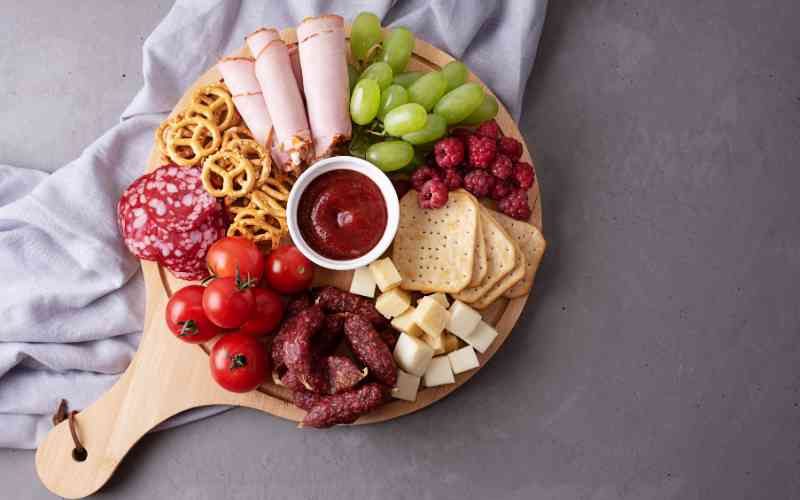Charcuterie boards have become increasingly popular as an appetizer or snack option. It is a delightful way to showcase your culinary prowess and impress your guests. Meat is one of the key components of a good charcuterie board.
Folding meat for a charcuterie board is visually appealing and allows for better portion control and ease of serving. In this article, we will guide you on how to fold meat for a charcuterie board that is not only delicious but also visually appealing.
Contents
How To Fold Meat For A Charcuterie Board (Step-by-Step Guide)
1. Choose the right type of meat
Many types of meat are suitable for a charcuterie board. When selecting meat for your board, choose a variety of textures and flavors to add depth and interest to your board.
Type Of Meat For Charcuterie Board
- Prosciutto: This delicate, thinly sliced Italian ham has a slightly sweet and salty flavor.
- Salami: With its rich, savory taste, salami comes in various styles like Genoa, Soppressata, and Chorizo.
- Coppa: This dry-cured pork shoulder has a bold, marbled appearance and a rich, complex flavor.
- Mortadella: A smooth and creamy Italian sausage with pistachios and peppercorns.
- Chorizo: A spicy and flavorful sausage that adds a kick to your charcuterie board.
2. Slice the meat thinly
When folding meat, it’s important to slice it thinly. This not only makes it easier to fold but also enhances the flavor and texture of the meat. Use a sharp knife to slice the meat as thinly as possible.
3. Lay the meat flat
Before folding the meat, lay it flat on a cutting board or other flat surface. This will make it easier to fold and prevent the meat from tearing.
4. Fold the meat in half
To create a simple fold, take one end of the meat and fold it over to meet the other end. This will create a half-moon shape. Repeat this process with all the slices of meat.
5. Roll the meat
Another option for folding meat is to roll it. To do this, take one end of the meat and roll it tightly into a cylinder shape. Repeat this process with all the slices of meat.
6. Fold the meat into a fan shape
For a more intricate fold, you can fold the meat into a fan shape. To do this, take one end of the meat and make small accordion-like folds, alternating the direction of the folds until you reach the other end of the meat.
7. Combine different folds
To add variety and interest to your charcuterie board, combine different types of folds. For example, you can fold some meat in half and roll others into cylinders. This will create a visually appealing and dynamic board.
8. Arrange the folded meat on the board
Once you have folded the meat, arrange it on the board. Start by placing the larger pieces of meat in the center of the board and then work your way outwards with the smaller pieces. This will create a visually appealing and balanced board.
9. Add garnishes
To enhance the flavor and presentation of the meat, add garnishes such as olives, nuts, dried fruit, and fresh herbs. These will not only add flavor but also add color and texture to your board.
10. Use dividers
If you want to keep the different types of meat separated, you can use dividers. Small bowls, ramekins, or even cheese knives can be used to create visual barriers between the different types of meat. This will not only make your board look more organized but will also help your guests navigate the board.
11. Consider the shape of your board
Charcuterie boards come in many different shapes and sizes, and the shape of your board can impact how you fold and arrange the meat. For example, if you have a circular board, you can arrange the meat in a spiral pattern, while a rectangular board may lend itself better to a linear arrangement.
Folding Tips
- When selecting meat for your charcuterie board, consider varying the textures. For example, you can include some meat that is smooth and creamy, such as mortadella, and others that are more firm and chewy, such as salami. This will not only add variety to your board but will also enhance the overall eating experience.
- When folding meat for a charcuterie board, it’s important to use the right tools. A sharp knife is essential for slicing the meat thinly, while kitchen shears can be used to trim any excess fat or rind. A small offset spatula can be used to help lift and fold the meat.
Presentation Tips
- Arrange folded meats in different styles to add visual interest.
- Add fresh herbs, edible flowers, or small fruits to enhance the flavor.
- Avoid overcrowding the board. Leave enough space between meats to allow for easy selection.
- If you have guests with dietary restrictions or preferences, it’s a good idea to label the different types of meat on your board. This will help your guests know what they can and can’t eat, and will also help them navigate the board.
Conclusion
In conclusion, folding meat for a charcuterie board can be a fun and creative process that adds visual appeal and enhances the flavor of the meat. By choosing the right type of meat, slicing them thinly, and using a variety of folds, you can create a visually appealing and dynamic board that is sure to impress your guests.
Don’t forget to add garnishes and consider the temperature of the meat when arranging it on the board.
Related:

